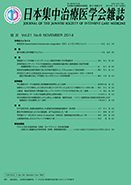Volume 21, Issue 6
Displaying 1-16 of 16 articles from this issue
- |<
- <
- 1
- >
- >|
HIGHLIGHT IN THIS ISSUE
-
2014 Volume 21 Issue 6 Pages 593-594
Published: November 01, 2014
Released on J-STAGE: November 14, 2014
Download PDF (192K)
REVIEW ARTICLE
-
2014 Volume 21 Issue 6 Pages 595-600
Published: November 01, 2014
Released on J-STAGE: November 14, 2014
Download PDF (279K)
ORIGINAL ARTICLES
-
2014 Volume 21 Issue 6 Pages 601-606
Published: November 01, 2014
Released on J-STAGE: November 14, 2014
Download PDF (349K) -
2014 Volume 21 Issue 6 Pages 607-613
Published: November 01, 2014
Released on J-STAGE: November 14, 2014
Download PDF (777K) -
2014 Volume 21 Issue 6 Pages 614-622
Published: November 01, 2014
Released on J-STAGE: November 14, 2014
Download PDF (280K) -
2014 Volume 21 Issue 6 Pages 623-629
Published: November 01, 2014
Released on J-STAGE: November 14, 2014
Download PDF (423K)
CASE REPORTS
-
2014 Volume 21 Issue 6 Pages 631-634
Published: November 01, 2014
Released on J-STAGE: November 14, 2014
Download PDF (418K) -
2014 Volume 21 Issue 6 Pages 635-638
Published: November 01, 2014
Released on J-STAGE: November 14, 2014
Download PDF (638K) -
2014 Volume 21 Issue 6 Pages 639-643
Published: November 01, 2014
Released on J-STAGE: November 14, 2014
Download PDF (607K) -
2014 Volume 21 Issue 6 Pages 644-648
Published: November 01, 2014
Released on J-STAGE: November 14, 2014
Download PDF (283K) -
2014 Volume 21 Issue 6 Pages 649-653
Published: November 01, 2014
Released on J-STAGE: November 14, 2014
Download PDF (450K)
BRIEF REPORTS
-
2014 Volume 21 Issue 6 Pages 655-656
Published: November 01, 2014
Released on J-STAGE: November 14, 2014
Download PDF (277K) -
2014 Volume 21 Issue 6 Pages 657-658
Published: November 01, 2014
Released on J-STAGE: November 14, 2014
Download PDF (590K) -
2014 Volume 21 Issue 6 Pages 659-660
Published: November 01, 2014
Released on J-STAGE: November 14, 2014
Download PDF (213K) -
2014 Volume 21 Issue 6 Pages 661-662
Published: November 01, 2014
Released on J-STAGE: November 14, 2014
Download PDF (485K)
COMMITTEE REPORT
-
2014 Volume 21 Issue 6 Pages 663-668
Published: November 01, 2014
Released on J-STAGE: November 14, 2014
Download PDF (912K)
- |<
- <
- 1
- >
- >|
